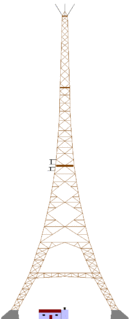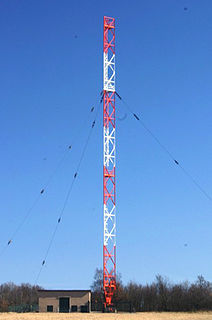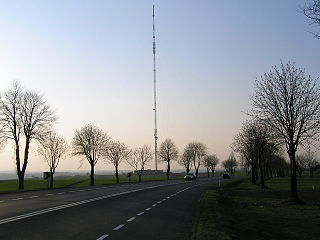
The Warsaw Radio Mast was a telecommunications tower located near the town of Gąbin, central Poland, and the world's tallest structure at 646.38 metres (2,120.7 ft) from 1974 until its collapse on 8 August 1991. It was the second tallest structure ever built, being surpassed as tallest by the Burj Khalifa, completed in 2009.

Sender Zehlendorf is a radio transmission facility which has been in service since 1936, when a short wave transmitter was built in Zehlendorf as part of the establishment of permanent radio services. This Zehlendorf site, which until the end of World War II was referred to as the Rehmate Radio Transmission Centre, had 26 different antennas.

The Mühlacker Broadcasting Transmission Facility is a radio transmission facility near Mühlacker, Germany, first put into service on November 21, 1930. It uses two guyed steel tube masts as aerials and one guyed steel framework mast, which are insulated against ground. It has two transmission aerials for shortwave and one free standing steel framework tower for directional radio services. The shortwave transmitter was shut off on October 19, 2004. The medium wave transmitter was switched off in January 2012.

The Langenberg transmission tower is a broadcasting station that transmits MW, FM and TV signals. It is located in Langenberg, Velbert, Germany and has had a very turbulent history since its inauguration. The transmitter first went into service in 1927 with 60 kilowatts (kW) of power and a T-aerial hanging on two 100-metre freestanding steel-frame towers insulated against ground.

The Transmitter Hamburg-Billstedt is a broadcasting facility in Hamburg-Billstedt, established in 1934. It is owned and operated by the Norddeutscher Rundfunk public broadcasting service, but open to competitors, too.

The Transmitter Ismaning was a large radio transmitting station near Ismaning, Bavaria, Germany. It was inaugurated in 1932. From 1932 to 1934 this transmitter used a T-antenna as transmitting antenna, which was spun between two 115-metre-high free-standing wooden lattice towers, which were 240 metres apart. As this antenna had an unfavourable vertical radiation pattern, which produced much skywave resulting in a too small fading-free reception area at night, in 1934 a new antenna was installed. Therefore, one of the towers was dismantled and rebuilt on a 39-metre-high (128 ft) wooden lattice base. While this work took place, an L-Antenna was used, which was spun between the other tower and a small auxiliary wooden tower. It became defunct in 1977 and was destroyed in 1983.

The Rheinsender is a large medium-wave transmission facility near Wolfsheim, southwest of Mainz for the frequency 1017 kHz. The Rhine transmitter was established in 1950 and went on the air May 15, 1950. It belongs to SWR and transmitted until the middle of the 1990s with 600 kilowatts. In the last years the transmission power was reduced to 100 kilowatts.

Radio masts and towers are, typically, tall structures designed to support antennas for telecommunications and broadcasting, including television. There are two main types: guyed and self-supporting structures. They are among the tallest human-made structures. Masts are often named after the broadcasting organizations that originally built them or currently use them.

The Tacolneston transmitting station is a facility for both analogue and digital VHF/FM radio and UHF television transmission near Tacolneston, 11 miles (18 km) south-west of Norwich, Norfolk, England.

The Lichfield transmitting station is situated close to Tamworth in Staffordshire in the West Midlands between the A5 and A51. The nearest geographical feature is Hopwas Hill. The station is owned and operated by Arqiva. The mast is known locally as Hopwas mast or Hints mast.

The Wiederau transmitter is the oldest broadcasting facility in Saxony. It is located near Wiederau, a village which is part of the municipality of Pegau, and is used for medium-wave, FM and Television broadcasting.

Marnach transmitter was a broadcasting facility of RTL near Marnach in the commune of Munshausen, in northern Luxembourg. The Marnach transmitter was built in 1955 for improving the transmission of the English-speaking program on 1439 kHz, which was transmitted from 1951 with an omnidirectional antenna from Junglinster, to the British Isles and for a better transmission on this frequency to Germany at daytime. Therefore, it was given a directional antenna with a switchable directional characteristic pointing North-northeast towards the Rhine-Ruhr area, Germany's most populated area, and West-northwest in the direction of the UK. This antenna was implemented in form of a directional antenna consisting of three ground-fed 105-metre tall guyed mast antennas arranged in the form of an isosceles triangle with a 90 degree angle. As transmitters, two 100 kW units switched in parallel were used when it went in service in December 1955.

The Bungsberg telecommunications tower is a 179-metre-high telecommunications tower situated on the Bungsberg, a hill which is the highest point in the north German state of Schleswig-Holstein.

Dillberg transmitter is a transmitting facility of the Bavarian Broadcasting Company on the 595-metre-high Dillberg mountain west of Neumarkt in der Oberpfalz, Bavaria, Germany. Dillberg transmitter went into service in 1955 for serving the area of Nuremberg with TV and FM radio programmes from a 198-metre-tall guyed mast.

Weiskirchen transmitter, which is property of the Hessian broadcasting company is a mediumwave broadcasting facility, situated in the northwest area of the hessian village Weiskirchen, which is a part of Rodgau, close of the motorway A 3.
Hoher Meissner transmitter is a facility for FM and TV broadcasting on Hoher Meissner mountain in Northern Hesse. The transmitter was inaugurated in 1952.

Piaski transmitter is a facility for FM- and TV-broadcasting near Piaski in Lublin Voivodeship, Poland at 51°08′02″N22°52′11″E. Piaski transmitter uses as antenna tower a 342 metre tall guyed mast, which was built in 1990. The mast of Piaski transmitter was at its completion the 5th, today after collapse of Warsaw Radio Mast it is the 4th tallest structure of Poland.
Venets Transmitter is a facility for FM and TV-broadcasting near Venets and Samuil in Shumen Province, Bulgaria. Venets Transmitter uses as antenna tower a 302 metre tall guyed lattice steel mast with rectangular cross section. This mast, which was built in 1975, is the tallest radio mast in Bulgaria. The TV transmitter, which used it as antenna, was the most powerful TV transmitter in Bulgaria with 50 kW. It broadcast the program of BNT 1 on channel 5 and could be received in Romania, Moldova and Ukraine. In 2008 due to interference with foreign FM radio stations the transmitter was shut down and broadcasting of BNT 1 was switched to channel 56 on a new NEC transmitter. The analogue transmitters were shut down on September 30, 2015 when simulcast period ended and Bulgaria switched to DVB-T.

The Emley Moor transmitting station is a telecommunications and broadcasting facility on Emley Moor, 1 mile (1.6 km) west of the village centre of Emley, mid-way between the villages of Kirkburton and West Bretton, in turn between Huddersfield and Wakefield, West Yorkshire, England. It is made up of a 1,084-foot-tall (330.4 m) concrete tower and apparatus which began transmitting in 1971. It is protected under UK law as a Grade II listed building. It is the tallest freestanding structure in the United Kingdom, seventh-tallest freestanding structure and fourth-tallest tower in Europe outside Russia, and 24th-tallest tower in the world.
Berlin-Köpenick transmitter was a transmission facility for broadcasting on medium wave, short wave, and VHF in Berlin-Köpenick, Germany, near the suburb of Uhlenhorst, after which it was occasionally named.